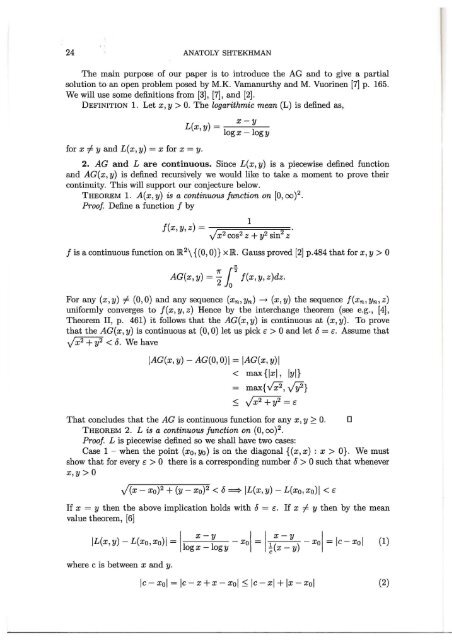Create successful ePaper yourself
Turn your PDF publications into a flip-book with our unique Google optimized e-Paper software.
24 ANATOLYSHTEKHMAN<br />
·'<br />
ARITHMETIC-GEOMETRIC MEANS 25<br />
The main purpose of our paper is to introduce the AG and to give a partial<br />
solution to an open problem posed by M.K. Vamanurthy and M. Vuorinen [7] p. 165.<br />
We will use some definitions from [3], [7], and [2].<br />
DEFINITION 1. Let x, y > 0. The logarithmic mean (L) is defined as,<br />
x-y<br />
L(x,y) = ----=----<br />
logx - logy<br />
since<br />
we obtain<br />
ix- xoi, iY- xoi < 8 and ic- xi < ix- Yi<br />
ic- xi+ ix- xoi ~ ix- Yi + 8 ~ ix- xoi + ixo - Yi + 8 ~ 38<br />
for x # y and L(x, y) = x for x = y.<br />
2. AG and L are continuous. Since L(x, y) is a piecewise defined function<br />
and AG ( x, y) is defined recursively we would like to take a moment to prove their<br />
continuity. This will support our conjecture below.<br />
THEOREM 1. A(x, y) is a continuous function on [0, oo) 2 .<br />
Proof Define a function f by<br />
1<br />
f( X, y, Z) = ---;::::====::::::;;:=<br />
y' x 2 cos 2 z + y 2 sin 2 z<br />
f is a continuous function on ~ 2 \ {(0, 0)} x ~. Gauss proved [2] p.484 that for x, y > 0<br />
AG(x, y) = ~ 1" f(x, y, z)dz.<br />
For any (x, y) # (0, 0) and any sequence (xn, Yn) ---+ (x, y) the sequence f(x n, Yn, z)<br />
uniformly converges to f(x, y, z) Hence by the interchange theorem (see e.g., [4],<br />
Theorem II, p. 461) it follows that the AG(x, y) is continuous at (x, y). To prove<br />
that the AG(x, y) is continuous at (0, 0) let us pick c > 0 and let 8 = c. Assume that<br />
y'x 2 + y 2 < 8. We have<br />
iAG(x, y)- AG(O, O)i = iAG(x, y)i<br />
< max{ixi , iYi}<br />
max{fx2,Vij2}<br />
< y'x2 +y2 = c<br />
That concludes that the AG is continuous function for any x, y ~ 0.<br />
THEOREM 2. L is a continuous function on (0, oo) 2 .<br />
Proof L is piecewise defined so we shall have two cases:<br />
Case 1 - when the point (xo, Yo) is on the diagonal {(x, x) : x > 0}. We must<br />
show that for every c > 0 there is a corresponding number 8 > 0 such that whenever<br />
x,y > 0<br />
y'(x - xo) 2 + (y- xo) 2 < 8 =====> iL(x, y) - L(xo, xo) i < c<br />
If x = y then the above implication holds with 8 = c. If x # y then by the mean<br />
value theorem, [6]<br />
iL(x, y) - L(xo, xo)i =<br />
where cis between x andy.<br />
I x-y I I x - y I<br />
1 og x - 1 og y c x - y<br />
- xo = 1 ( ) - xo = ic - xo l<br />
ic - xoi = ic - x + x - xoi ~ ic - x i + ix - xoi (2)<br />
D<br />
(1)<br />
Therefore ic- x 0 i ~ 38. Hence by 1 and 2 it is clear that if we take 8 < ~ the<br />
implication<br />
y'(x- x 0 )2 + (y- xo) 2 < 8 =====> iL(x, y)- L(xo, xo)i < c<br />
holds for all x, y > 0.<br />
Case 2 - when the point is not on the diagonal. In this case L(x, y) is continuous<br />
as a composition of continuous functions such as xjy, x-y, and log(x). That concludes<br />
the proof. D<br />
3. Is AGt ~ L for some t E (0, 1). It is well known that A(x, y) ~ G(x, y).<br />
This can be generalized to a weighted mean inequality<br />
whenever w 1 , w 2 ~ 0 and w 1 + w2 = 1. To read more about weighted and modified<br />
inequalities we suggest [1]. In 1991 B.C. Carlson and M. Vuorinen proved that<br />
AG(x, y) ~ L(x, y) (3)<br />
More recently inequalities similar to 3 have been studied involving means "modified"<br />
in the following way:<br />
DEFINITION 2. For real numbers t # 0, we define<br />
Mt (X' y) = M (X ' y ) t '<br />
where M can be any of the means: G, AG, or L.<br />
For example,<br />
1<br />
t t<br />
AGt = AG ( x , y ) t ,<br />
Lt (X' y) = L (X ' y ) t •<br />
AGt has many properties of AG. In particular since the function xt is continuous for<br />
x > 0 so composed with Theorems 2 and 3 we obtain the following result:<br />
COROLLARY 3. Ift > 0 then AGt(x, y) and Lt(x, y) are continuous functions on<br />
(0, oo) 2 .<br />
However, if we modify AG in the inequality 3, its behavior is not entirely clear:<br />
PROBLEM 4. Does there exists a t E (0, 1 ) so that AGt dominates L, i.e. so that<br />
AGt(x, y) ~ L(x, y)for all x, y > 0 ?<br />
THEOREM 5. For positive x andy both AGt(x, y) and Lt(x, y) are continuous,<br />
strictly increasing functions oft.<br />
Proof See Theorem 1.2 of [7]. D<br />
THEOREM 6. AGt(x, y) < L(x, y) for all t E (0, ~) and x, y E ~+.<br />
t<br />
t<br />
t<br />
t<br />
1<br />
1
















